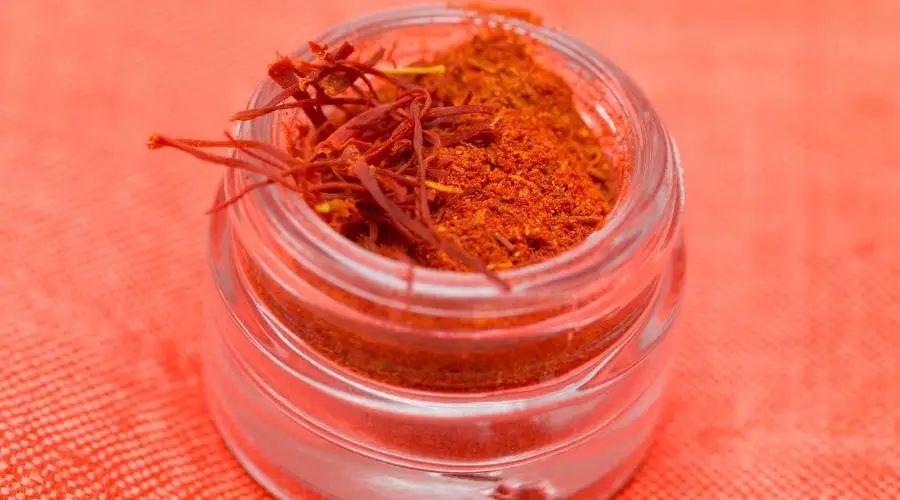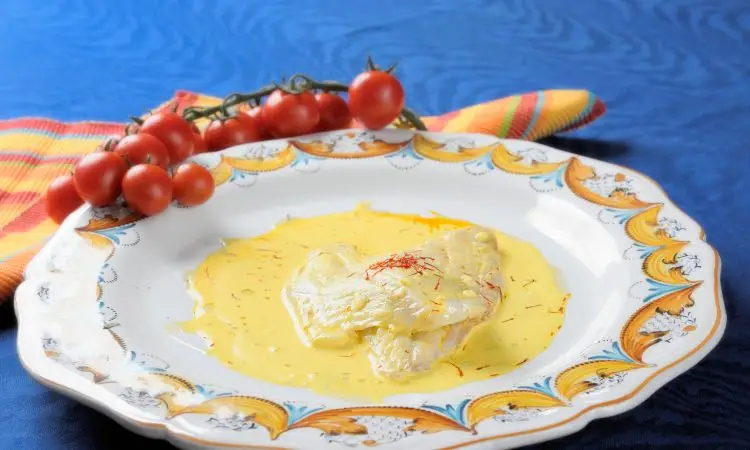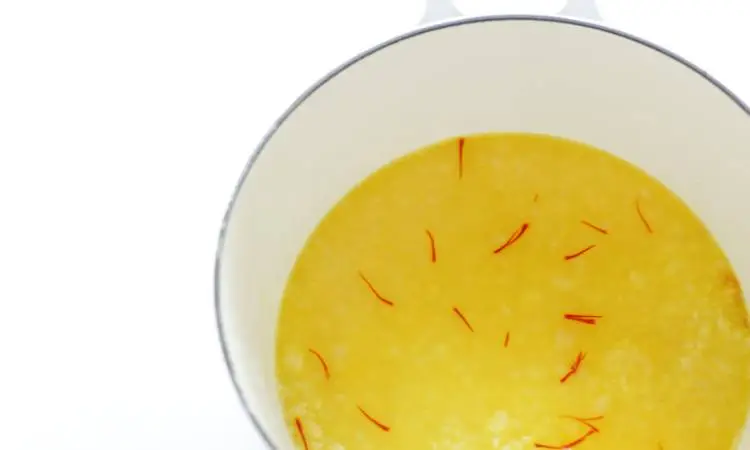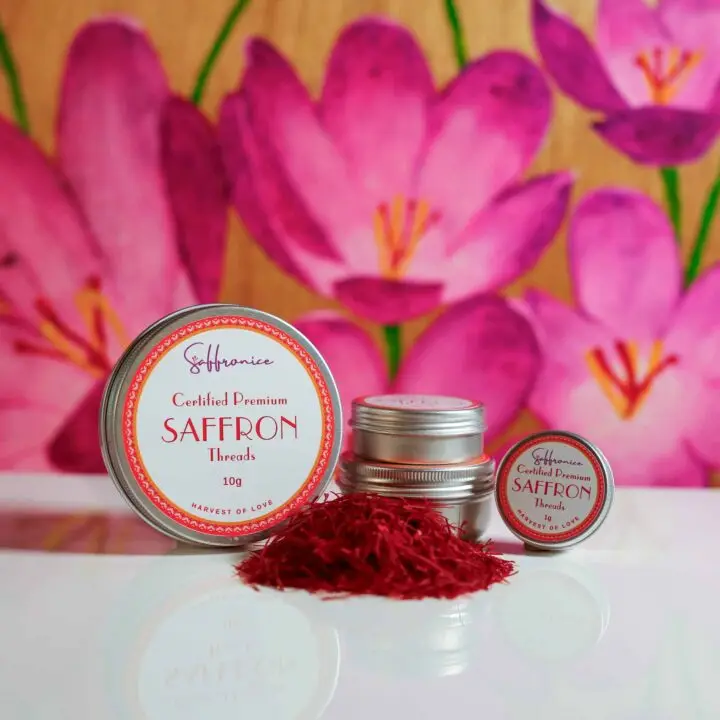📌 Quick Answer: Saffron is the world’s most expensive spice, harvested from Crocus sativus flowers with only 3 stigmas per bloom. It requires 70,000 flowers to produce one pound, costing $500-$5,000. Used for 4,000 years in cooking, medicine, and religious practices, saffron offers antioxidants, mood benefits, and a distinctive golden color to dishes worldwide.
Getting to Know the Golden Spice
Saffron represents the pinnacle of spice luxury, with its vibrant red threads and extraordinary culinary properties. Understanding what saffron is reveals why this precious ingredient has captivated cultures for millennia. Coming from the Crocus sativus flower, saffron consists of the flower’s crimson stigmas—those tiny threads hidden within each purple bloom.
The remarkable challenge lies in saffron’s yield: each flower produces only three precious threads. This scarcity, combined with the labor-intensive harvesting process, establishes saffron as one of the world’s most challenging spices to harvest. Throughout history, people have treasured saffron for multiple purposes—adding it to food for flavor and color, creating perfumes, producing natural dyes, and developing traditional medicines.
Chef’s Professional Tip: In professional kitchens, we treat each saffron thread with utmost respect. The spice’s intensity means that proper technique can transform an ordinary dish into an extraordinary culinary experience.
Food Scientist’s Note: Saffron’s unique properties come from three primary compounds: crocin (responsible for color), safranal (providing aroma), and picrocrocin (delivering flavor). These compounds work synergistically to create saffron’s unmistakable profile.

The Economics of Saffron Production and Pricing
Saffron cultivation begins with planting in late summer, followed by an intensive autumn harvest period. From late October through early November, farmers engage in meticulous hand-harvesting, collecting flowers one by one. This back-breaking work explains saffron’s position at the top of spice price charts worldwide.
The mathematics of saffron production reveals its economic reality: approximately 1,000 flowers yield just one ounce of saffron, while nearly 70,000 flowers are required to produce a single pound. Understanding saffron harvesting methods illuminates why this process demands such premium pricing.
Saffron Production Economics
| Measurement | Flower Requirement | Market Value |
|---|---|---|
| 1 gram | 150 flowers | $15+ retail |
| 1 ounce | 1,000 flowers | $400-500 |
| 1 pound | 70,000 flowers | $500-$5,000 |
Price variations depend on multiple factors, including thread quality, geographic origin, processing methods, and purity levels. When purchasing saffron, consumers often invest $15 or more for just one gram, making it literally worth more than gold by weight. Knowing where to buy quality saffron helps ensure value for this significant investment.
Remarkable Health Benefits and Medicinal Properties
Saffron transcends culinary applications, functioning as nature’s pharmacy in tiny red strands. Used therapeutically for nearly 4,000 years, saffron’s health benefits extend far beyond its paella appearances. Comprehensive saffron health benefits research reveals why this spice has maintained its medicinal reputation across cultures and centuries.
Primary Therapeutic Properties
| Property | Health Benefit | Scientific Support |
|---|---|---|
| Antidepressant | Mood enhancement, depression relief | Clinical trials show efficacy |
| Neuroprotective | Memory support, cognitive function | Research demonstrates brain benefits |
| Antiproliferative | Cellular health support | Laboratory studies indicate potential |
| Hypolipidemic | Blood lipid management | Studies suggest cardiovascular support |
Research indicates that saffron for depression may rival conventional treatments for mild to moderate depression while producing fewer side effects. This natural approach to mood support represents a significant breakthrough in integrative wellness strategies.
Powerful Antioxidant Protection
Saffron’s antioxidant compounds, including crocin, picrocrocin, and safran, all function as cellular guardians, protecting against free radical damage and oxidative stress. These compounds work synergistically to support overall health and potentially prevent various diseases.
Crocin: Acts as a powerful cellular protector while reducing inflammation throughout the body.
Picrocrocin: Supports cognitive function, potentially enhancing learning capacity and memory retention.
Safranal: Provides mood-lifting properties, contributing to emotional well-being and mental clarity.
These antioxidant benefits extend beyond general health maintenance, specifically supporting brain function and potentially protecting against neurodegenerative conditions.
Emotional Well-being and Mental Health Support
Saffron’s mood-enhancing effects extend beyond its vibrant appearance. Research on saffron mood regulation demonstrates significant potential for supporting emotional balance and mental wellness. Multiple studies comparing saffron to placebo treatments show meaningful improvements in mild to moderate depression symptoms.
Clinical trials comparing saffron to conventional treatments reveal comparable effectiveness with gentler side effect profiles, making it an attractive option for individuals seeking natural mood support approaches.
Mastering Saffron in the Kitchen
Learning how to cook with saffron properly unlocks this spice’s full potential, transforming ordinary ingredients into extraordinary culinary experiences. The key lies in understanding proper handling, activation, and incorporation techniques that maximize both flavor and visual impact.
Proper Thread Usage and Measurements
Saffron threads require careful measurement and handling to achieve optimal results. These delicate strands deliver both golden color and complex flavor, combining earthiness with subtle sweetness. Direct addition to hot liquids provides the most effective extraction method.
| Dish Type | Thread Quantity | Application Method |
|---|---|---|
| Rice (full pot) | 10-12 threads | Soak then add with liquid |
| Soups | 5-6 threads | Direct addition to broth |
| Pasta | 5-6 threads | Include in the cooking water |
| Desserts | 4-5 threads | Infuse in milk or cream |
Activating Saffron’s Full Potential
Proper saffron activation requires heat, moisture, and patience to release maximum color and flavor compounds. Grinding threads with a mortar and pestle before soaking enhances extraction efficiency.
Professional Activation Process:
- Gently grind saffron threads using a mortar and pestle
- Soak ground saffron in warm water, broth, or milk for 10-15 minutes
- Stir the saffron-infused liquid thoroughly into the dishes
This soaking process ensures complete distribution of saffron’s beneficial compounds throughout the preparation.
Culinary Applications Across Dish Categories
Saffron’s versatility shines across diverse culinary applications, from traditional preparations to innovative modern creations.
Rice Dishes: Saffron excels in paella, risotto, and traditional saffron rice dishes, providing both signature color and distinctive flavor.
Soups and Broths: Bouillabaisse and seafood soups benefit from saffron’s aromatic enhancement and visual appeal.
Pasta and Grains: Saffron elevates pasta and quinoa preparations with exotic flavor complexity.
Desserts: Custards, syrups, and sweet preparations gain sophisticated flavor notes from careful saffron integration.
Saffron’s Global Culinary Journey
Saffron’s worldwide influence spans continents and cultures, earning the nickname “red gold” for its precious status in international cuisines. Its distinctive aroma, striking appearance, and unique taste profile make it indispensable in both traditional and contemporary cooking applications.
Traditional Cultural Applications
European, North African, and Asian cuisines have incorporated saffron for centuries, with each culture developing distinctive preparation methods that highlight the spice’s versatility. Its honey-like aroma, combined with woody and earthy notes, creates the signature golden-yellow appearance that defines countless traditional recipes.
Spanish Traditions: Paella represents Spain’s most famous saffron application, showcasing the spice’s ability to unify diverse ingredients.
Indian Heritage: Biryani and sweet treats like Kheer demonstrate saffron’s importance in Indian culinary traditions.
Persian Legacy: Persian saffron cuisine features Tahdig and roasted chicken preparations that highlight Iran’s mastery of this precious spice.

International Signature Dishes
| Country | Signature Dish | Key Characteristics |
|---|---|---|
| Spain | Paella | Rice with seafood, vegetables, and saffron |
| India | Biryani | Aromatic rice with meat, spices, and saffron |
| Persia | Tahdig | Crispy rice with golden saffron crust |
| France | Bouillabaisse | Fish stew with saffron-infused broth |
| Middle East | Saffron Rice Pudding | Creamy dessert with saffron essence |
These cultural applications demonstrate saffron’s ability to enhance both savory and sweet preparations while contributing distinctive regional character to traditional dishes.
Production, Processing, and Quality Standards
Understanding saffron’s journey from field to table reveals why this spice commands premium pricing and requires careful quality assessment. The complex process involves precise harvesting, controlled drying, systematic grading, and proper storage to maintain optimal characteristics.
Labor-Intensive Harvesting Requirements
Saffron harvesting demands exceptional human labor and infinite patience. Each Crocus sativus flower contributes merely three precious stigmas, requiring massive flower quantities for meaningful saffron production. Consider these production requirements: 150 flowers produce one gram, while 70,000 flowers are necessary for one pound of finished saffron.
Farmers typically invest $300-400 per pound in production costs alone, explaining the significant price differential between farm-gate and retail pricing.
Critical Drying and Processing Methods
Post-harvest drying requires a precise technique to preserve saffron’s color, aroma, and beneficial properties. Whether using traditional air-drying methods or specialized equipment, the goal remains consistent: maintaining quality while removing moisture that could compromise long-term storage.
Quality Assessment and Grading Systems
Saffron quality standards follow international ISO 3632 protocols, evaluating color intensity (crocin), flavor strength (picrocrocin), and aroma potency (safranal). Premium grades feature vivid red threads without yellow or white portions, ensuring maximum potency and culinary impact.
Storage Requirements: Proper saffron storage methods involve dark, cool environments using opaque containers that protect against light, heat, and moisture exposure.
| Quality Factor | Premium Standard | Storage Requirement |
|---|---|---|
| Color | Deep crimson red | Opaque packaging |
| Aroma | Rich, honey-like | Cool, dry environment |
| Texture | Dry, brittle threads | UV light protection |
Cultural Heritage and Historical Significance
Saffron’s history and origins span millennia, weaving through countless cultural traditions and spiritual practices worldwide. This precious spice has served as currency, medicine, dye, and sacred offering throughout human civilization.
Spiritual and Religious Importance
Saffron’s role in spirituality and religion demonstrates its profound significance beyond culinary applications. In Buddhism, saffron dyes monks’ robes, symbolizing humility, detachment from worldly possessions, and spiritual devotion. Buddhist temples regularly receive saffron offerings as expressions of faith and reverence.
Hindu Religious Practices
Hinduism embraces saffron as “kumkum,” used for forehead markings during religious rituals that signify purity and sanctity. During festivals like Holi, saffron creates the vibrant colored powders that celebrate spiritual joy and community unity.
| Tradition | Saffron Application | Symbolic Meaning |
|---|---|---|
| Buddhism | Robe dyeing, temple offerings | Humility, devotion |
| Hinduism | Forehead markings, festivals | Purity, sanctity |
Cross-Cultural Symbolism
Ancient civilizations, including Greeks, Romans, and Egyptians, valued saffron as a multi-purpose treasure serving medicinal, cosmetic, and romantic purposes. This historical versatility explains saffron’s continued cultural significance and premium status across diverse societies.
Modern culinary applications honor this rich heritage while exploring innovative preparations that respect traditional wisdom while embracing contemporary creativity.
Conclusion: Embracing Saffron’s Timeless Appeal
Saffron represents far more than an expensive spice—it embodies thousands of years of human cultivation, cultural tradition, and culinary artistry. From its labor-intensive production process to its remarkable health benefits and versatile culinary applications, saffron continues earning its status as one of the world’s most treasured ingredients.
Understanding saffron’s complexity—from proper sourcing and storage to activation techniques and cultural significance—empowers both home cooks and professional chefs to utilize this precious spice effectively. Whether preparing traditional dishes that honor centuries-old techniques or creating innovative preparations that explore new flavor territories, saffron offers unlimited potential for culinary expression.
Key Takeaways:
- Quality sourcing ensures authentic flavor and maximum health benefits
- Proper activation through soaking releases optimal color and aroma compounds
- Traditional techniques from global cuisines provide proven preparation foundations
- Health benefits extend beyond culinary applications to support overall wellness
- Cultural heritage adds depth and meaning to contemporary saffron usage
The investment in quality saffron pays dividends through enhanced flavor, visual appeal, potential health benefits, and connection to rich cultural traditions that span continents and centuries. Every thread carries the legacy of countless generations who recognized saffron’s extraordinary value.



